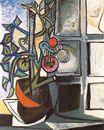©Пабло Пикассо - Куст томата 1944
 |
 |
 |
 |
 |
 |
 |

Куст томата 1944
92x73см холст/масло
Private Collection
The image is only being used for informational and educational purposes
<< Previous G a l l e r y Next >>
From Sotheby's:
Symbolic of victory in Europe, Picasso's paintings of a tomato plant in bloom are considered some of the most important works that he produced during the war years. Although his work of this period tended to avoid direct references to the war, these pictures are imbued with both personal and cultural significance.
In the summer of 1944, when the Allied forces began to advance towards Paris and the end of Nazi Occupation was in sight, Picasso could not help but to be embroiled in current events. For the first time since completing his epic Guernica in 1937, he made direct references in his pictures to life in Europe during the war. While staying with Marie-Thérèse and their daughter Maya at the Boulevard Henri IV in the weeks before the Liberation of Paris, Picasso took notice of the potted tomato plant that was growing besides the window of the apartment. Potted fruit-bearing plants such as these were not uncommon in civilian households throughout Europe during this period, when food rations limited the amount of available produce for consumption. Seeing the resilient plant as a sign of hope as it continued to blossom and bear fruit, Picasso began a series of four drawings of the theme that July, and eventually developed his ideas onto canvas for an oil series.
Between August 3 and August 12, 1944, Picasso painted nine canvases of a potted tomato plant, with its vines tethered to a supporting stake and positioned in front of a window. Varying in degrees of abstraction, this series incorporated vestiges of the artist's early Cubist style, as well as the bold modeling and shadowing that characterized many of his wartime still-lifes. The present work was painted on August 7, about mid-way through Picasso's production of this series. According to Zervos, Picasso's interest in this subject began on July 27, when he executed four preliminary drawings for these paintings, including one that specifically relates to the present work.